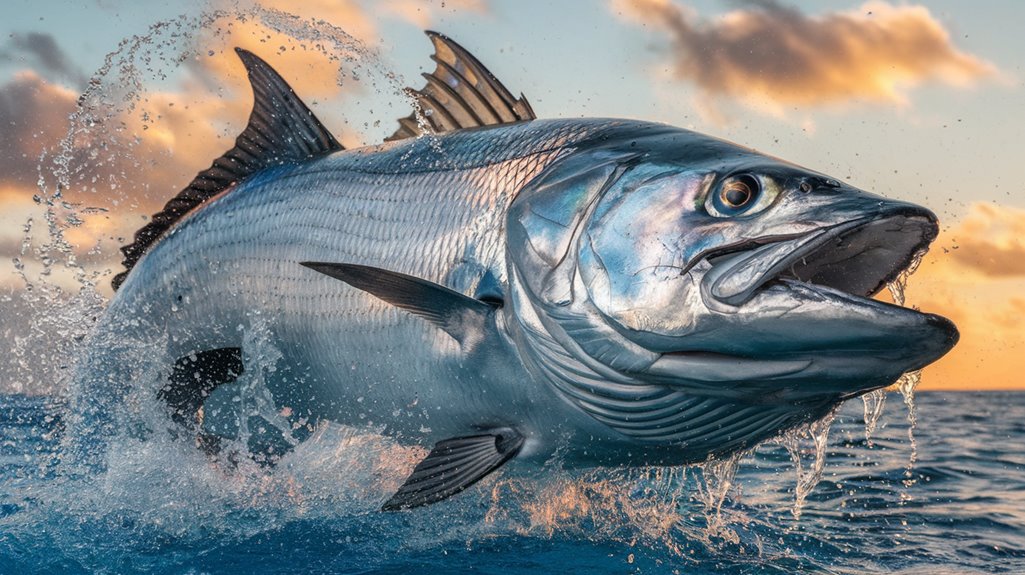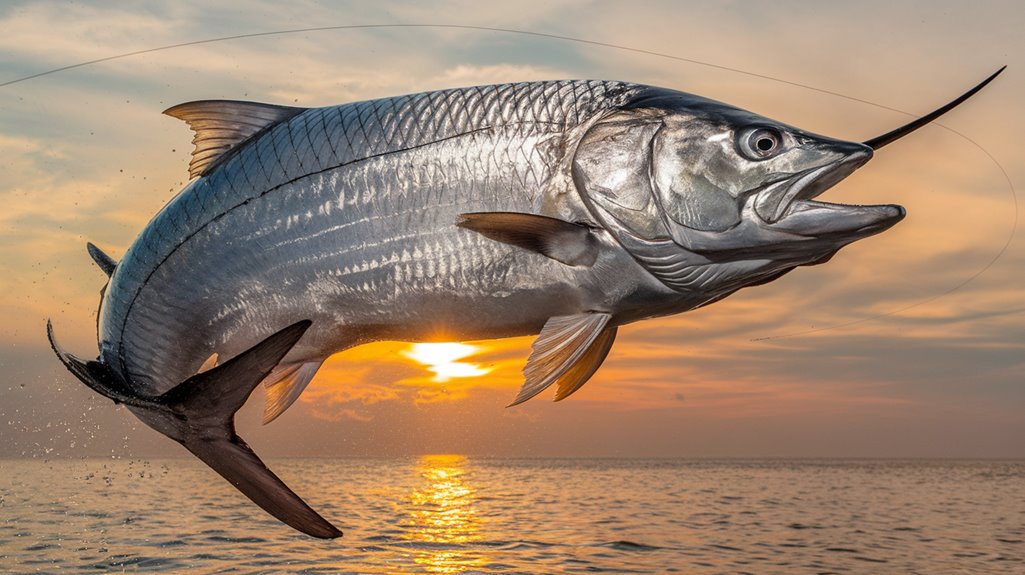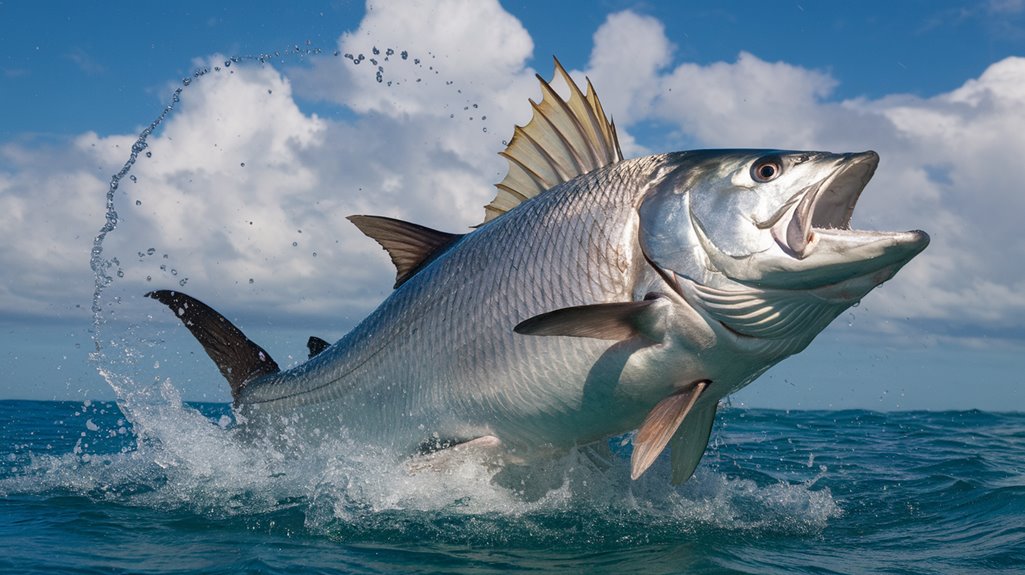Did you know that tarpon can process oxygen from both their gills and their swim bladder, allowing them to survive in waters with oxygen levels as low as 0.5 parts per million? You'll discover how these ancient fish, dating back over 100 million years, have evolved remarkable adaptations that make them one of sport fishing's most prized catches. Understanding their unique biology and behavior patterns will transform your approach to targeting these silver kings.
Key Takeaways
- Atlantic Tarpon can propel themselves up to 10 feet above water, showcasing their spectacular acrobatic abilities during fights with anglers.
- These magnificent fish possess a unique swim bladder that allows them to gulp air, enabling survival in oxygen-poor environments.
- Tarpon can reach impressive sizes of up to 8 feet in length and weigh between 50-200 pounds, making them trophy catches.
- Their spawning rituals follow lunar cycles, with massive schools gathering in shallow waters during full moons from April through June.
- These long-lived fish can survive up to 50 years and migrate extensively along coastlines following seasonal patterns.
The Remarkable Biology of Atlantic Tarpon
Atlantic tarpon stand as true marvels of marine evolution, demonstrating extraordinary physical capabilities that set them apart from other fish species. You'll find these giants reaching lengths of up to 8 feet and weights between 50 to 200 pounds, equipped with a remarkable jumping ability that propels them 10 feet above the water's surface.
Their specialized swim bladder allows them to gulp air directly, adapting to oxygen-poor environments that would challenge other fish. As a long-lived species surviving up to 50 years, they undertake extensive migratory journeys from the Gulf of Mexico to river estuaries during spawning season. This impressive longevity and their significant size have made them prime targets for catch-and-release fishing practices, ensuring the sustainability of these magnificent creatures for future generations.
Peak Seasons and Migration Patterns
You'll find tarpon migrations follow lunar cycles, with peak activity during full moons from April through June when massive schools gather in shallow waters for spawning rituals. Your best chances for landing these magnificent fish occur as they move through coastal waters of the Gulf of Mexico, particularly near bridges and passes where salt and fresh water mix. During summer months, you can target post-spawn tarpon that exhibit more aggressive feeding behavior, especially around landmarks like the Sunshine Skyway and other tidal mixing zones.
Moon Phase Migration Timing
Following natural lunar cycles, tarpon exhibit distinct migration patterns that peak during spring months, with coordinated movements southward for pre-spawn activities and northward post-spawn from April through July. You'll find ideal fishing conditions during full moons, particularly from April through June when spawning activity intensifies. After July's full moon, expect more dispersed populations and less predictable catches.
| Moon Phase | Tarpon Behavior |
|---|---|
| Full Moon April | Peak Pre-spawn Migration |
| Full Moon May | Maximum Spawning Activity |
| Full Moon June | Active Feeding Patterns |
| Full Moon July | Population Dispersal |
Post-spawn summer tarpon display increased aggression in mixed-salinity waters, while tidal changes drive their feeding activity. You'll experience the most productive catches during moving tides, especially in estuarine environments where fresh and salt waters converge.
Seasonal Spawning Hot Spots
During peak migration season from April through July, tarpon congregate in massive numbers at specific spawning grounds, with Boca Grande Pass serving as the epicenter of activity. You'll find excellent fishing opportunities in coastal waters where freshwater meets saltwater, particularly during full moon phases when spawning activity intensifies.
As the undisputed "Tarpon Capital of the World," Boca Grande offers exceptional live bait fishing conditions when these prehistoric gamefish gather in vast schools. After the July spawn, tarpon migration patterns shift, with fish becoming significantly more aggressive in their feeding behavior. You'll discover prime saltwater fishing along the Gulf of Mexico's coastline, where tarpon follow predictable routes through passes and beaches. These spawning hot spots consistently produce trophy-class catches, especially in areas where tidal flows create ideal feeding conditions.
Gulf-to-Coast Movement Patterns
As water temperatures climb above 75°F in spring, tarpon begin their annual southward migration along the Gulf Coast, creating prime fishing conditions that peak between April and July. You'll find large schools gathering in shallow waters where rivers meet the sea, particularly during full moon phases when spawning activity intensifies.
Peak fishing season aligns perfectly with their migration patterns, offering you favorable opportunities near bridges and coastal passes. You'll notice their behavior and habitat preferences shift after the July full moon, as post-spawn tarpon migrate northward. For successful tarpon fishing, target areas where fresh and saltwater mix, especially the productive zones around structures like the Sunshine Skyway Bridge. Remember that their activity levels depend heavily on water temperature, with the sweet spot ranging between 75-85°F.
Essential Gear and Tackle Selection
The selection of proper fishing gear stands as the cornerstone of successful tarpon fishing. You'll need a 7-8 foot medium-heavy to heavy action rod paired with a reel that can handle 30-80 pound test lines. For peak performance, equip your setup with a 20-30 pound fluorocarbon leader and circle hooks, which enhance catch-and-release success while protecting the fish.
| Component | Specification | Purpose |
|---|---|---|
| Rod Length | 7-8 feet | Leverage Control |
| Line Test | 30-80 pound | Fighting Strength |
| Leader | 20-30 lb fluorocarbon | Bite Resistance |
| Hook Type | Circle hooks | Safe Release |
Your tackle selection should include a smooth drag system to manage powerful runs. When sight-casting, opt for a 12 wt. fly rod, or use live bait such as palm-sized fish and crabs for traditional setups.
Advanced Fishing Techniques and Strategies

Building upon your gear foundation, mastering advanced tarpon fishing techniques will maximize your success on the water. You'll want to employ sight fishing during moving tides, particularly in early morning or late afternoon when tarpon are most active. While live bait options like menhaden and pass crab prove effective, artificial lures including topwater plugs and swimbaits can be equally productive during migration season.
To enhance your fishing techniques, implement a strategic approach combining trolling with jigs and chumming in areas where strong currents concentrate tarpon. Understanding tarpon behavior is vital – they're more likely to feed during tide changes. When targeting these powerful fish, you'll achieve a more successful day by adapting your presentation based on conditions. Remember to use circle hooks and minimize handling time to protect these magnificent gamefish.
Prime Fishing Locations and Hotspots
You'll find tarpon congregating under bridges after sunset, where they actively feed on baitfish attracted to artificial lighting. During peak migration from April to July, you can track large schools as they move through coastal passes like Boca Grande, creating prime fishing opportunities at these natural bottlenecks. Your success rate will increase by targeting these seasonal meeting points during tidal changes, particularly in the mixing zones where fresh and salt water converge.
Bridge Hotspots After Dark
While daytime tarpon fishing presents its challenges, bridge hotspots after dark offer anglers exceptional opportunities for landing these prized gamefish. Your night fishing experience under illuminated bridges can yield remarkable results, especially at renowned locations like the Sunshine Skyway and MacDill Air Force Base.
To maximize your tarpon fishing trip success after dark:
- Position yourself where bridge lights create bright spots on the water, making it easier to spot rolling tarpon
- Implement corking techniques with live bait in areas where tarpon are actively feeding
- Monitor the deep flats near Apollo Beach for acrobatic jumps, indicating prime fishing zones
The combination of patience, proper positioning, and strategic use of bridge lighting greatly enhances your chances of hooking these magnificent fish during nighttime hours.
Seasonal Migration Meeting Points
Moving beyond nighttime bridge locations, seasonal migration patterns create predictable gathering points that offer exceptional tarpon fishing opportunities. You'll find these acrobatic game fish congregating where salt and fresh water merge, particularly in inshore waters from Boca Grande to Homosassa. During spring's pre-spawn migration, popular spots include the deep flats off Apollo Beach and Mermaid Point, with peak activity from April to July around full moons. The Sunshine Skyway Bridge area becomes especially productive during quarter-moon tides. Understanding tarpon fishing regulations is essential as you target these meeting points, where you can employ live bait techniques or sight-casting methods. The seasonal migration creates ideal conditions at locations where waterways converge, presenting prime opportunities to encounter large schools during their northward post-spawn movement.
Conservation and Responsible Angling Practices

Because tarpon populations face ongoing pressures from habitat loss and fishing impacts, adopting responsible angling practices is critical for species conservation. When targeting these magnificent gamefish, you'll need to prioritize catch-and-release protocols and familiarize yourself with local fishing regulations, including seasonal closures and size restrictions.
To guarantee successful catch-and-release outcomes:
- Use circle hooks exclusively to minimize injury and increase survival rates
- Keep fish in the water during release and handle with wet hands or gloves
- Release immediately unless you have proper tagging permits
Your commitment to proper handling techniques directly influences tarpon populations' sustainability. By adhering to these conservation guidelines, you're contributing to the preservation of this iconic species while maintaining the integrity of the recreational fishery for future generations.
Frequently Asked Questions
What's so Special About Tarpon?
You'll find tarpon exceptional for their massive size up to 200 pounds, spectacular 6-foot aerial leaps, impressive 70-year lifespan, and unique ability to breathe air in low-oxygen waters.
How Old Is a 100 Pound Tarpon?
Like reading nature's diary, you'll find a 100-pound tarpon is typically 12 to 15 years old, with its age varying based on regional water temperatures and local food availability.
Is Tarpon Good Eating?
You won't find tarpon enjoyable as table fare due to their tough, oily flesh and dense connective tissues. They're primarily valued as game fish, with most anglers practicing catch-and-release.
Who Caught the World Record Tarpon?
You'll find that Frank J. H. DeLuca caught the world record tarpon in 1975 near Boca Grande, Florida. His IGFA-certified catch weighed 286 pounds and measured 84 inches long.
Conclusion
You've explored the intricate world of Megalops atlanticus, from their distinctive swim bladder adaptations to their strategic migration routes. With the proper gear configuration and refined angling methodologies, you'll optimize your success rate in pursuing these silver monarchs. Remember, you're not just participating in a sport; you're engaging with a legacy species that requires your stewardship for future generations to experience these aerial ballet performers of the coastal waters.

